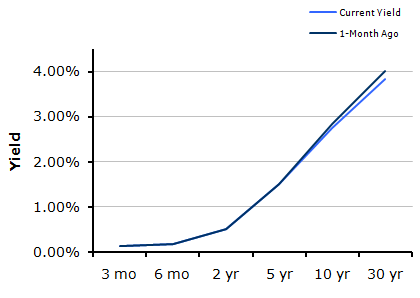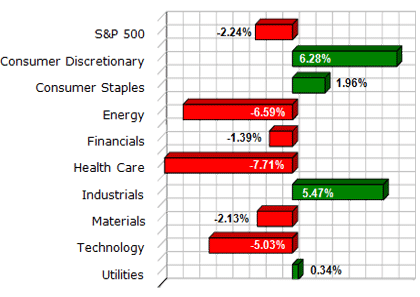
Market Commentary by Scott J. Brown, Ph.D., Chief Economist

After what has seemed like a long string of disappointing economic data releases, reports turned more mixed this week – consistent with a near-term slow patch in economic growth, but not a double dip. The stock market embraced the positive reports and ignored the bad (for the most part).
The August Employment Report was not a great report, but it was good relative to expectations. Nonfarm payrolls fell by 54,000, reflecting a decline of 114,000 in temporary census workers. Figures for June and July were revised a net 133,000 higher. Private-sector payrolls rose by 67,000 (vs. expectations of about 40,000), while figures for June and July were revised a net 66,000 higher: July’s revised figure showed a gain of 107,000 (compared to a rise of 71,000 reported a month ago) and June’s figure was revised to show a gain of 61,000 (compared to an earlier-reported gain of 31,000). August temp-help payrolls rose by 17,000 following virtually no gain in July. The unemployment rate edged up to 9.6% – from 9.5% in July – reflecting a pickup in labor force participation (a result of the extension of unemployment insurance benefits).
The Federal Open Market Committee (FOMC) minutes from the August 10 policy meeting indicated that divisions among senior Fed officials were nowhere near as sharp as portrayed in the financial press. There was broad agreement that employment and inflation would likely fall short of expectations. The risk of deflation was downplayed, although most FOMC members saw some risk of disinflation (a falling inflation rate). The FOMC minutes, along with the recent economic data, suggest that the Fed may be unlikely to take extra steps anytime soon.
Next week, the economic calendar thins out considerably. Monday is a holiday. The Fed’s Beige Book, due out Wednesday, provides a good anecdotal summary of economic conditions around the country, but is usually not a market-mover. The trade deficit is expected to narrow some after widening sharply in recent months. President Barack Obama is expected to propose further efforts to boost the job market.
Indices
| Last | Last Week | YTD return % | |
| DJIA | 10320.1 | 9985.81 | -1.04% |
| NASDAQ | 2200.01 | 2118.69 | -3.05% |
| S&P 500 | 1090.1 | 1047.22 | -2.24% |
| MSCI EAFE | 1471.96 | 1420.64 | -6.88% |
| Russell 2000 | 632.26 | 599.76 | 1.10% |
Consumer Money Rates
| Last | 1-year ago | |
| Prime Rate | 3.25 | 3.25 |
| Fed Funds | 0.25 | 0.25 |
| 30-year mortgage | 4.34 | 5.2 |
Currencies
| Last | 1-year ago | |
| Dollars per British Pound | 1.539 | 1.628 |
| Dollars per Euro | 1.281 | 1.429 |
| Japanese Yen per Dollar | 84.240 | 92.140 |
| Canadian Dollars per Dollar | 1.053 | 1.104 |
| Mexican Peso per Dollar | 13.059 | 13.654 |
Commodities
| Last | 1-year ago | |
| Crude Oil | 75.02 | 68.05 |
| Gold | 1250.75 | 977.55 |
Bond Rates
| Last | 1-month ago | |
| 2-year treasury | 0.52 | 0.51 |
| 10-year treasury | 2.74 | 2.83 |
| 10-year municipal (TEY) | 3.55 | 4.23 |
Treasury Yield Curve – 9/03/2010

S&P Sector Performance (YTD) – 9/03/2010

Economic Calendar
| September 6th | — | Labor Day Holiday (markets closed) |
| September 8th | — | Fed Beige Book |
| September 9th | — | Jobless Claims (week ending September 4th) Trade Balance (July) |
| September 14th | — | Retail Sales (August) |
| September 15th | — | Industrial Production (August) |
| September 17th | — | Consumer Price Index (August) |
| September 21st | — | Building Permits, Housing Starts (August) FOMC Meeting |
| October 8th | — | Employment Report (September) |
Important Disclosures
Past performance is not a guarantee of future results. There are special risks involved with global investing related to market and currency fluctuations, economic and political instability, and different financial accounting standards. The above material has been obtained from sources considered reliable, but we do not guarantee that it is accurate or complete. There is no assurance that any trends mentioned will continue in the future. While interest on municipal bonds is generally exempt from federal income tax, it may be subject to the federal alternative minimum tax, state or local taxes. In addition, certain municipal bonds (such as Build America Bonds) are issued without a federal tax exemption, which subjects the related interest income to federal income tax. Investing involves risk and investors may incur a profit or a loss.
US government bonds and treasury bills are guaranteed by the US government and, if held to maturity, offer a fixed rate of return and guaranteed principal value. US government bonds are issued and guaranteed as to the timely payment of principal and interest by the federal government. Treasury bills are certificates reflecting short-term (less than one year) obligations of the US government.
Commodities trading is generally considered speculative because of the significant potential for investment loss. Markets for commodities are likely to be volatile and there may be sharp price fluctuations even during periods when prices overall are rising. Specific sector investing can be subject to different and greater risks than more diversified investments.
Tax Equiv Muni yields (TEY) assume a 35% tax rate on triple-A rated, tax-exempt insured revenue bonds.
![]() Material prepared by Raymond James for use by its financial advisors.
Material prepared by Raymond James for use by its financial advisors.
The information contained herein has been obtained from sources considered reliable, but we do not guarantee that the foregoing material is accurate or complete. Data source: Bloomberg, as of close of business September 2nd, 2010.
©2010 Raymond James Financial Services, Inc. member FINRA / SIPC.


